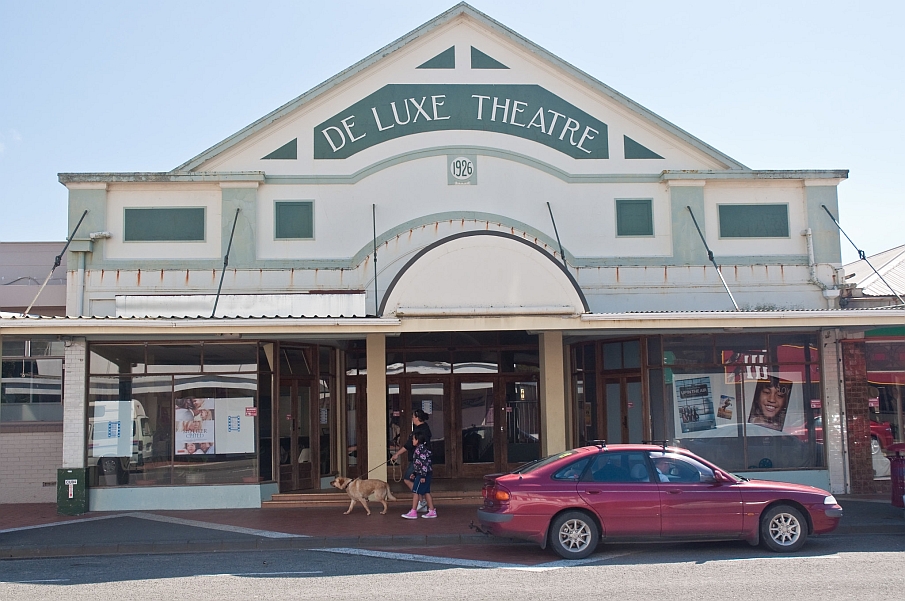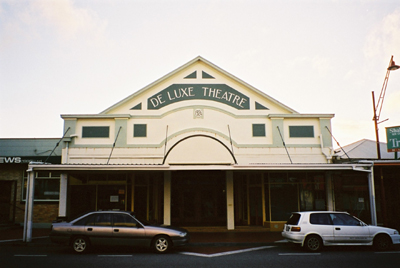The De Luxe Theatre is an early surviving example of provincial cinema architecture, which has been at the heart of social life in Opotiki for several generations. Erected in 1926, the building was commissioned as part of the local commercial empire created by the Shalfoon cousins, George (?-1943) and Stephen (?1874-1942) in the eastern Bay of Plenty. The Shalfoons successfully established themselves in Opotiki after emigrating from the Lebanon during the 1890s. Their businesses included a successful drapery and general store, a furniture-making enterprise, and a shipping service which brought people into the town from smaller settlements along the East Cape. The theatre was erected immediately to the south of their general store on Church Street, with visitors arriving from the wharves likely to walk past the long shop frontage before entering the cinema. Passage on the ships was free providing that goods were purchased from their stores. The De Luxe initially hosted stage shows as well as silent films, and also incorporated specialist shops. As a purpose-built structure, the building had commercial advantages over rival establishments in the town, including the Regent Hall, which was opened at the same time in adapted premises. The gala opening of the De Luxe featured a silent film, 'The White Sister' and a live band - the Melody Boys - led by George's son, Epi Shalfoon (1904-1953). Of Te Whakatohea as well as Lebanese ancestry, Epi ran a music shop in the complex before going on to achieve national fame as a dance band musician and a Musicians' Union representative. The opening was attended by the cinema magnate, Robert Kerridge (1901-1979), who went on to create the largest exhibition chain in New Zealand and Australia in the following decades. Kerridge leased the building shortly after it opened as one the first cinemas outside his Gisborne base, renaming it the Regent. Said to have been erected by a builder, Bill Wild, the picture theatre was built of concrete, with plastered brick and a corrugated iron roof. Its visual design fused aspects of both traditional public hall and commercial architecture, reflecting its association with communal entertainment as well as retail. The resulting eclecticism is evident in the main facade, which unusually combines a gabled roof end above a centrally-arched parapet. The structure's 'newness' was proclaimed by the date '1926' over the main door and its contemporary interior décor, such as a coved ceiling with linear detailing in the foyer. The latter contained stairs to a dress circle in the auditorium, while the auditorium itself held a timber stage, below which a pianist and other musicians sat when accompanying silent films. New projection equipment was introduced in the late 1920s, when the earliest talkies were introduced. The first talking picture to be shown was Al Jolson's 'The Jazz Singer', while by 1933 a typical programme consisted of the Paramount News, Metro News, Our Gang Comedy, and a cartoon, followed by the main feature 'When a Fella needs a Friend'. The cinema was refurbished after a fire to the stage in 1961, and was again modified in 1972 while still under lease to Kerridge Odeon. It was the oldest cinema in the Kerridge chain at the time of its closure in 1981. Subsequently purchased by the Opotiki Community Theatre Trust, the building reverted to being known as the De Luxe. It has been modified further to reveal some of the building's original features, allowing both films and live entertainment to be shown once again. The De Luxe Theatre is significant as one of the earliest picture theatres to be incorporated in the Kerridge cinema chain, and is believed to be the oldest of these still operational. It is a valuable example of 1920s theatre architecture erected in a small-town context. The building is associated with the widespread extension of cinema into provincial New Zealand, and has been used continuously for entertainment since the age of silent films. It is associated with the history of live entertainment as well as that of moving pictures. The building is associated with significant individuals, including Robert Kerridge and Epi Shalfoon. It demonstrates Opotiki's function as a cultural and commercial centre within the eastern Bay of Plenty, and has played a pivotal role in the social life of the settlement, as shown by its purchase by the local community in the 1980s. Having streetscape values, the building forms part of an important historic precinct in the commercial centre of the town. It has close links with adjacent historic buildings, including the former Shalfoon and Francis shops, and the Opotiki Hotel, where the wife of Epi Shalfoon once lived.


Location
List Entry Information
Overview
Detailed List Entry
Status
Listed
List Entry Status
Historic Place Category 2
Access
Able to Visit
List Number
3498
Date Entered
4th April 1984
Date of Effect
4th April 1984
City/District Council
Ōpōtiki District
Region
Bay of Plenty Region
Legal description
Lot 1 DP 2948 Lot 1 DP 9134 AK & Pt Allot 4 Sec 1 Town of Opotiki
Related listings
Stay up to date with Heritage this month
